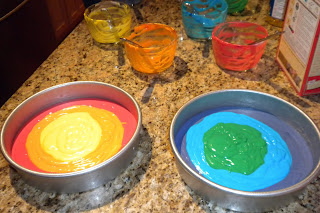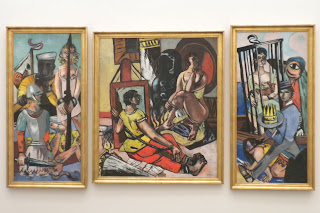I might as well have been named Cassandra, because my sense of foreboding turned out to be fully realized on our only full day in Boston. We woke up to rain, which abated slightly during breakfast, such that it was merely drizzling by the time we headed out to tackle part of Boston's historic "Freedom Trail," which leads you past all of the city's significant colonial and revolutionary-era sights.

The Freedom Trail website says that it is paved in red brick. I wasn't exactly expecting a tiny stripe in the sidewalk...
Our first stop along the Trail (after leaving Boston Commons, a park that used to serve as the community grazing area for livestock) was the Granary Burial Ground, founded in 1660, and home to some of the heroes of the American Revolution, including John Hancock, Samuel Adams, Paul Revere, and the victims of the Boston Massacre. I was particularly interested in the funerary iconography of the graves, as I had never seen a cemetery dating back to such an early era of American history. Evidently, because the Puritans did not believe in religious icons, the tombs represent a idiosyncratic melange of secular death imagery, including bones, hourglasses (to mark the end of one's time on earth), and winged skulls known as "soul effigies," which were intended to symbolize the soul's ascent to heaven.

Two things I love in one photo: fall foliage, and crumbling old cemeteries. This was by far my favorite destination in our brief tour of Boston.
A pair of neat 18th century tombstones. The one on the top shows the popular "soul effigy" motif, which was by far the most prevalent in the cemetery, and the one beneath depicts a small hourglass at the bottom.

Dad and I with the 19th century marker that was dedicated to Paul Revere after it was deemed that his original, humble marker was not befitting of his iconic status in American history.
From the cemetery, we followed the Freedom Trail onward to see King's Church, an Anglican house of worship erected by the King of England for his soldiers and other colonial officials, which had to be carved out of a piece of public land as the Puritan Bostonians refused to allow the construction of an Anglican church in their fair hamlet. We then headed past the Old State House, where Boston's famous patriots debated the Stamp Tax and outside of which the Boston Massacre occurred, to Faneuil Hall.

Fanueil Hall, with its statue of Samuel Adams in front.
Although Fanueil Hall was originally constructed as a house of commerce (a purpose that it still fulfills today as the site of numerous tourist shops and food stalls), its historical legacy stems from its role as a meeting house during the Revolution. At Fanueil Hall, Bostonians protested the Stamp, Sugar, and Townshend Acts, Samuel Adams held a publicity stunt for the cause of independence by staging a funeral for the victims of the Boston Massacre, and the Sons of Liberty held a series of meetings which culminated in the Boston Tea Party.
By the time we had seen Fanueil Hall, the skies had opened up and unleashed a flood of torrential rain, so we were forced to abandon our sightseeing endeavor and head over to Harvard, where we were to attend a luncheon featuring guest speaker, Elizabeth Warren. Elizabeth Warren is a faculty member at Harvard Law School, but is better known as the Chair of the Congressional Oversight Panel, which "review[s] the current state of financial markets and the regulatory system," and was created last year during the current global economic crisis. I had seen her previously on The Daily Show, so at least I was familiar with her work, and she was relatively interesting, even if the food at the event had been sitting out for an indeterminate amount of time, and was pretty horrendous.
Before setting out for another touristic effort, Dad also posed for the Class of 1979 group photo, where he was finally able to locate some of the friends with which he has kept in touch over the years. However, that moment of success was overshadowed by the failure of our attempt to see the Old North Church, site of Paul Revere's famous "one if by land, two if by sea," lantern display.
I could tell we were doomed when the taxi driver didn't seem to know what we were talking about when we asked for the Old North Church and asked for the address, which, of course, we were unable to provide. Dad told him it was in the North End, Boston's Little Italy neighborhood, so the cab driver dropped us off at the edge of it, leaving us completely lost, with only an incomplete map of the city featuring the Freedom Trail that I had printed off of Google Maps before we left Chicago. Several rounds of advice from directionally-challenged locals later, we finally found the structure. There, we were able to catch a brief lecture on the history of the church, which was mostly notable for the speaker who was in possession of a "wicked-awesome" Boston accent, and the fact that we got to sit in the unusual boxed-in pews, which were designed to keep out drafts during the bitter Massachusetts winters, and which cost families the equivalent of thousands of dollars to rent out for their private use.

It wasn't until we were able to find this statue of Paul Revere that Dad finally got oriented and we were able to figure out where we were. In the background is the famous steeple where the lanterns were hung.
Our final destination for the day brought us back to Cambridge for Dad's class dinner. The event was moderately more tolerable than the buffet of the previous evening, and it somewhat solidified my sense that the true silver lining in the entire experience has been the window that it has opened on Dad's life in a time before I was ever even a glimmer on the horizon. His friends recalled the famous Farrah Faucet poster prominently displayed on his dorm room wall, and with a great deal of camaraderie they discussed the various professors that had alternately inspired and frustrated them among other aspects of their shared experiences at Harvard. Given the confident, commanding presence my father has become, it was interesting to imagine him as an intimidated, nervous, young student fresh off the proverbial turnip truck. It has given me a greater respect for everything that he has accomplished in his life, and for that I am grateful, even if the majority of my Boston experience was not something I would care to repeat.

Dad with his law school pals, Mike Clark (left) and Ralph Canada (center).

 1995: Not one of my best costumes ever, but this society maven ensemble makes an important point about Halloweens in Chicago: it is always cold and often rainy. This costume enabled some genius practicality: faux fur-trimmed gloves, and an actual mink stole that Mom found at a estate auction. In fact, I can't remember a year when winter coats and layering weren't involved in my trick-or-treating experience. Even this year, after a week of temperatures in the 50s and 60s, it fell into the 40s just in time for Halloween. Thankfully though, I was so busy not celebrating today, that the drop in temperature had no effect on me.
1995: Not one of my best costumes ever, but this society maven ensemble makes an important point about Halloweens in Chicago: it is always cold and often rainy. This costume enabled some genius practicality: faux fur-trimmed gloves, and an actual mink stole that Mom found at a estate auction. In fact, I can't remember a year when winter coats and layering weren't involved in my trick-or-treating experience. Even this year, after a week of temperatures in the 50s and 60s, it fell into the 40s just in time for Halloween. Thankfully though, I was so busy not celebrating today, that the drop in temperature had no effect on me.














































